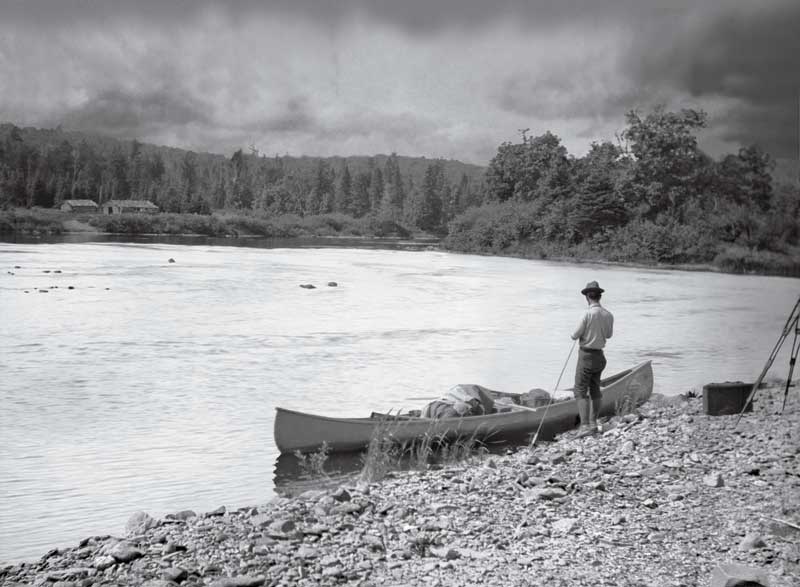Wood and Canvas Canoes
Twenty years ago I paddled down the St. John River in northern Maine on an eight-day wilderness canoe trip. I remember much about the rhythm of that ice-out trip: how the eight of us put in below Baker Lake into a shallow, smooth current. The water quickened and grew more powerful with each gathering day, […]

Photographer Bert Call (1866-1965) captured this scene of Moose Brook, where it joins the Androscoggin River in northern New Hampshire (E.M. White canoe in foreground). For information on the traveling show Maine’s Woods: Observations by Bert Lincoln Call & Henry David Thoreau, visit: callthoreauexhibit.com
Photo Credit : Bert CallTwenty years ago I paddled down the St. John River in northern Maine on an eight-day wilderness canoe trip. I remember much about the rhythm of that ice-out trip: how the eight of us put in below Baker Lake into a shallow, smooth current.
The water quickened and grew more powerful with each gathering day, keeping pace with our growing confidence. I remember the tender fiddleheads and wild brook trout cooked over open fires, and then poring over maps afterward, nervously anticipating the heavier water of Ledge Rapids, Priestly Rapids, and, looming beyond them like a final exam, the churning, rock-filled whitewater that awaited us below the confluence with the Big Black River.
Our guides, Garrett and Alexandra Conover, had learned to run the river the way generations of Maine Guides had before them: swinging paddles made of ash or poles made of spruce, in canoes made of cedar and canvas. The canoes were things of beauty–gracefully lined, marvelously responsive, flexible, strong, able to carry heavy gear while drawing hardly any water.
They’d been fashioned on an 18-foot 6-inch “Guide” model from the old E. M. White Canoe Company of Old Town, Maine. White canoes–based on the time-tested designs of the Penobscot and Malecite Indians–had been the canoes of choice for serious Maine sportsmen and Guides from the late 1800s until well after World War II and the ascendancy of cheaper, lighter, aluminum and fiberglass models.
Garrett and Alexandra had coated the bottoms with amber shellac to protect against rocks, and they’d struck brightly colored waterlines along the hulls, to show at a glance whether the loads were properly balanced and the vessels properly trimmed. Those of us who had never paddled wood-and-canvas boats treated them tenderly at first, before realizing how rugged they were.
I was amazed by how quietly mine slipped through the water, how effortlessly I could maneuver it. Running the Big Black rapids, I experienced the perfect marriage of material, form, and function, and it ruined me for synthetic canoes forever.
Two boatbuilders from Atkinson, Jerry Stelmok and Rollin Thurlow, had built our canoes, modifying an original White form slightly. Jerry had come by that form when he bought the Island Falls Canoe Company in 1975, over on the coast, in Lubec. Rollin had joined him a year later. They’d moved the business to Atkinson in 1977. The first few years were touch-and-go, and it wasn’t clear there was even a market for well-crafted, classic wooden canoes. “We were dumb enough, or fortunate enough,” Jerry liked to say, “to get into this business when there was no hope.”
At a low ebb, Rollin split off from the company, to focus on his own designs and on restoration and repairs. But the head start would prove fortuitous for them both. They hung in there, and caught the tailwater of a generation that fondly recalled paddling wooden Old Towns and E. M. Whites at summer camp; they caught the wave of interest spurred by the creation of WoodenBoat magazine (and soon after that, the WoodenBoat School, where they both, early on, became regular instructors).
Jerry wrote a definitive book on the subject, and then Jerry and Rollin wrote a book together. They sold a bunch of boats to a young couple named Conover, whose insistence on traditional guiding methods was earning them a flood of national publicity and a steady stream of like-minded clients. To keep up with production, Jerry moved into a larger shop a half-mile south, and then again to a still-larger shop another half-mile south. Rollin hired on year-round help.
Not long after my St. John trip, I got a call from Alexandra Conover. She’d heard about a couple of 40-year-old E. M. White “Guide” canoes for sale in Cherryfield, in the barn of a retired game warden. A buddy and I drove up from New Hampshire and bought the pair for $500 apiece. That winter we spent a week working alongside Rollin in his shop. We repaired cracked ribs, touched up planking, thwarts, and gunwales; stretched new canvas over the hulls; and got the boats in shape for another few decades of use.
Thirty-five years after they started, Jerry and Rollin are still at it. Jerry’s shop turns out 30 boats a year, including restorations. Rollin has a two-year backlog of work and a growing business supplying materials and hardware to do-it-yourselfers. Both are grateful for the Internet and their books and their teaching gigs and whatever else it takes. It’s still not a very big market.
I’ve put a lot of water under my E. M. White since I’ve owned it–loaded and empty, in all kinds of water. It’s still marvelously responsive and flexible, the marriage of material, form, and function as timeless and strong as ever. That strikes me as a pretty fair definition of “classic.”
To learn more about wood-and-canvas canoes, or to inquire about owning your own, contact Jerry Stelmok at Island Falls Canoe Co., 207-564-7612, islandfallscanoe.com, or Rollin Thurlow at Northwoods Canoe Co., 207-564-3667, wooden-canoes.com
Read more:The Guide and the Allagash


